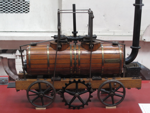General
D14: Hudswell Clarke D1373
0-6-0 diesel mechanical locomotive 'Mersey Docks and Harbour Board No. 45'
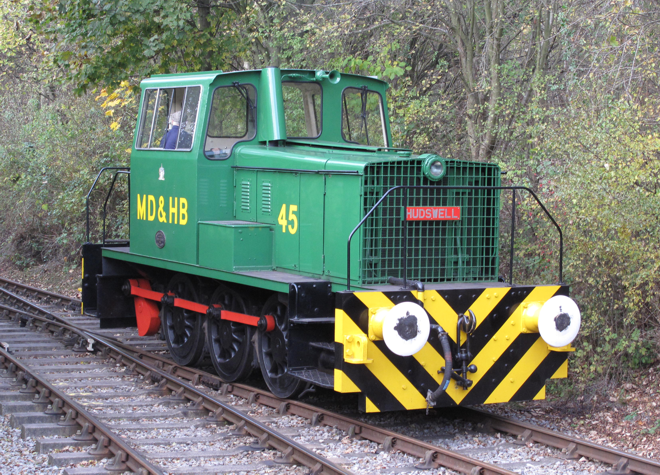
| Built | 1966, at Leeds |
| Weight | 36 tons |
| Length over buffers | 27' 0" (approx 8.2 m) |
| Driving wheels | 3' 8" diameter (approx 112 cm) |
| Engine | 8 cylinder Gardner 8L3-B, 260 hp |
| Previously worked | Mersey Docks and Harbour Board, Liverpool, then various locations for Esso (including Purfleet and Plymouth), and after preservation at the East Somerset Railway |
| Entered collection | Donated by the Sentinel Diesel Preservation Group in 2017 |
| Current status | Operational |
More details of this locomotive are given in our stockbook.
Go back to diesel locomotive D13: Hunslet 6981.
Return to the list of diesel locomotives.
More Information
Other pages provide more information about:
Safeguarding the Future Appeal
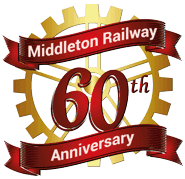 This is an appeal to help the Middleton Railway continue its work of commemorating the pioneers of steam power, John Blenkinsop and Matthew Murray, and the Leeds locomotive building industry that they helped create. Please read on to find out more about:
This is an appeal to help the Middleton Railway continue its work of commemorating the pioneers of steam power, John Blenkinsop and Matthew Murray, and the Leeds locomotive building industry that they helped create. Please read on to find out more about:
- the past that has inspired this appeal;
- the present that is leading to this appeal;
- the future need that this appeal is seeking to meet; and
- the appeal itself, and ways to donate.
The Past
The Middleton Railway in Leeds was authorised by Act of Parliament in 1758 to deliver coal to the centre of Leeds and has operated every year since then, making it the oldest continually operating railway in the World.
In 1812, thanks to the genius of John Blenkinsop and the skill and ingenuity of Leeds engineer Matthew Murray, the Middleton Railway became the first railway in the world to successfully employ steam power.
The pioneering role of the Middleton Railway resulted in Leeds becoming one of the major centres of locomotive building in the UK and laid the foundations for Leeds holding its pre-eminent position as a major research and development centre and home of a wide range of high tech industries.
In 1960 the Middleton Railway became the first volunteer run standard gauge heritage railway in the world – yet another first in its long history - and it is now run by the Middleton Railway Trust Limited.
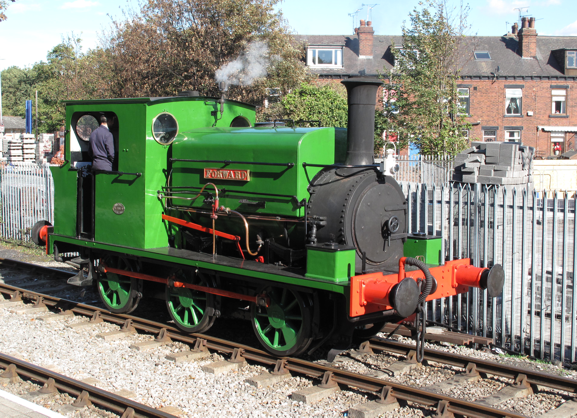
Matthew Murray representing MW 1690 Forward at our "Last Coals to Leeds" event, which comemmorated 50 years since the closure of Middleton Broom Pit [Picture © Tony Cowling, 2018]
The Present
Today the Middleton Railway continues to serve the people of Leeds by commemorating the pioneering role of Leeds and the Railway in developing Britain’s and the World’s railway systems, by preserving in working order steam and diesel locomotives typical of the products of the major Leeds locomotive builders and by offering the people of Leeds the opportunity to see and travel behind these historic machines as they work between the Railway’s operational base at Moor Road in South Leeds and Middleton Park.
The Railway, still operated entirely by volunteers, plays an active role in the life of Leeds, drawing volunteers, young and old, from all over Leeds and surrounding areas and specifically training young volunteers in the skills needed to operate and maintain its historic collection of locomotives and waggons.
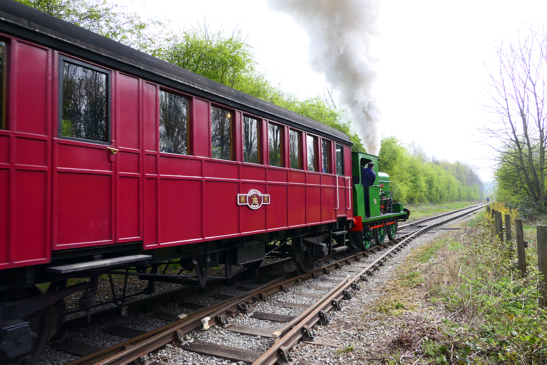
Our recently-converted party coach, in a train headed by Matthew Murray. [Picture © John Goacher, 2018]
The Future Need
The year 2020 is the Middleton Railway Trust’s Diamond Jubilee year. A number of projects were being considered for launch this year and there were other major projects which were to be brought to a conclusion. These projects include:
- preparations to expand the Railway’s museum, by creating a new gallery to better display the Railway’s collection of small exhibits, and so tell better the story of the links with John Blenkinsop and Matthew Murray
- the restoration of Conway, the largest steam locomotive in the Railway’s collection (built by Kitson of Kitson College fame),
- casting a new cylinder block for Matthew Murray, so that this historic, Leeds built, locomotive can steam on past its 150th birthday
- completing the restoration of ‘No. 6’ - a locomotive which had not run for nearly fifty years, and
- the construction of a fourth coach on a newly purchased chassis.
These various projects will involve young volunteers and will help to train them to become the custodians of the Middleton Railway’s heritage in the future.
Covid-19 has affected the Middleton Railway like many other charitable bodies. The Railway will survive Covid-19, as it has survived many cataclysmic events in its long life, but survival will come at a price, namely the rundown of the Railway’s financial reserves. This may mean that, without your support, many of the above projects will have to be deferred or even cancelled.
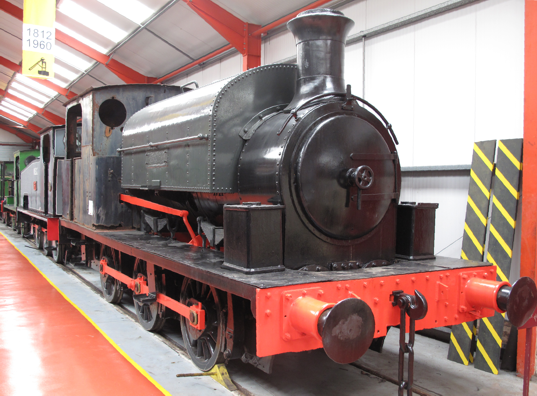
Conway in the Engine House, awaiting the completion of its cosmetic restoration [Picture © Tony Cowling, 2020]
The Appeal
To enable the Railway to continue with these and other projects, in 2020 the Middleton Railway Trust launched a new appeal ‘Safeguarding the Future’ to help the Trust overcome the damaging effects of Covid-19. If you wish to make a donation to this appeal, then there are various ways in which you can do so, as below. If you are also able to Gift Aid your donation, then this will increase its value to us by 25%, at no extra cost to you. We would strongly encourage you to use Gift Aid if you are eligible to do so: please see below for more details of the requirements for Gift Aid.
Online donations via GoFundMe
We have a page for our appeal at this funding website, and this will open in a separate browser tab or window. It uses the Paypal Giving Fund to send the donations to us, and this allows you to claim Gift Aid easily. They will email a receipt to you for your donation, and this includes a button which you can simply click to add a Gift Aid declaration for your donation.
Direct online donations
These are handled for us by PayPal in the ordinary way (so making a donation under Gift Aid this way involves a bit more work - see below for details.) Please click the button below to go to Paypal's page for donations to us.
Via our donation form
If you prefer not to use online payments, then you can access our form by clicking here, and it will open in a new browser tab or window so that you can download and print it. To add Gift Aid to this, please see the details below.
When you have filled in this form (and the Gift Aid declaration, if applicable), then please return it to us with your payment, either in person, or by post to: The Station, Moor Road, Hunslet, Leeds, LS10 2JQ.
In person at our shop
Once our shop is open again, then more information about the appeal will be available in the shop, and our shop staff will be happy to help you with the details. In 2020 our shop is scheduled to re-open on 2nd August: click here for more details.
Donation by text
To donate £5 to the appeal, you can simply text RAILWAY 70085 . This will cost you £5 plus one standard rate message, and you’ll be opting in to hear more about our work and fundraising via telephone and SMS. If you’d like to give £5 but do not wish to receive marketing communications, then please text RAILWAYNOINFO to 70085.
To donate more (up to a limit of £20), then please text RAILWAY followed by the amount to 70085. For instance, to give £10 text RAILWAY 10 to 70085.
You will receive a text message in reply, and this will include a link to the web site of Donr, which you can use to make a Gift Aid declaration for your text donation.
Donation by telephone
If you would prefer to contact us by telephone, on 0113 271 0320, then we can answer any questions that you may have about the appeal and take the details of your donation. We can accept payment by credit or debit card, and we accept most payment cards, except American Express & Diners Card. This does mean that donations made this way need to be of more than £5.
Gift Aid
If you are a taxpayer then you can use Gift Aid to increase the value of any donation that you make by 25%, at no extra cost to you. You will need to complete a Gift Aid declaration, and some of the donation methods described above allow this to be done online. For the other methods, you can access a declaration form by clicking here, and it will open in a new browser tab or window, so that you can download the form and print it.
This declaration form explains the requirements of the Gift Aid scheme. Note that for some types of tax you need to be paying more than the standard allowance for these to qualify you as a taxpayer.
If you are able to complete this declaration form and return it to us, either with a donation form or after making a donation in any of the other ways listed above, then we can then claim back the standard rate income tax that you have already paid on the amount of your donation. This does not cost you a penny!.
Indeed, if you have to pay income tax at higher rate and have to complete a tax return, then including the details of donations that you have made under Gift Aid will reduce the amount of higher-rate tax that you have to pay.
Our Thanks
The Trust recognises that these are very challenging times for many people and that there are many other Charities seeking the support of the public. The Trust will be very grateful for all contributions to this Appeal and will make sure that these contributions are used wisely to help the Railway continue to serve the people of Leeds.
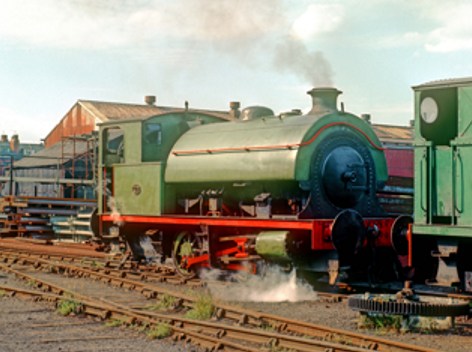
No. 6 in Dartmouth yard in 1974 [Picture © Charles Milner, 1974]
More Information
Other pages provide more information about:
Archive Images
 2020 was the Middleton Railway's diamond jubilee year, but it was also the year of the coronavirus (COVID-19), and so the railway was not able to open as it had originally planned.
2020 was the Middleton Railway's diamond jubilee year, but it was also the year of the coronavirus (COVID-19), and so the railway was not able to open as it had originally planned.
To try to compensate for this, we put up on this page a selected set of photographs from our archives, showing key aspects of the Middleton Railway over that time. We also circulated these photographs on social media, with excerpts from their captions, using the following heading:
Middleton Railway - serving the community for 60 years.
To create a historical record, we have now put these images into chronological order as far as possible, although for some of them we only have very approximate dates, and so the ordering may not be exact. We have also revised the captions, both to update the historical details where necessary, and to reduce the amount of repetition that resulted from sending each one out separately with the photograph to which it referred.
The Original 1960 Passenger Train
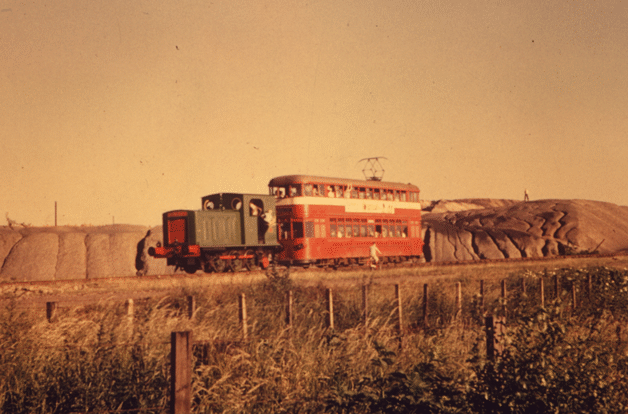
The Swansea and Mumbles Car No. 2, with HE 1697, during the university Rag Week.
This picture shows one of the Middleton Railway's original passenger trains, following its preservation. These trains were run during the university Rag Week in 1960, starting on Monday 20th June, with the first one departing at 16:45. At this time the locomotive HE 1697 was still on loan to the railway, while the Swansea and Mumbles coach No. 2 had only arrived at the railway at the end of the previous week. It had been delivered as a train consisting of three separate wagon-loads (bogies, lower deck and upper deck), and had been re-assembled during the weekend. (Note that, while it might look like a tram, it was actually a double-decked coach, with railway wheels rather than tramway wheels.)
The photograph was almost certainly taken from the footpath which ran almost parallel to the railway. This had previously been the trackbed of what was technically the Middleton Light Railway: in other words, the Leeds City Tramways line which ran up through Middleton Woods to Middleton, and then continued round and down Belle Isle Road back towards the centre of town. This footpath still exists, although it is now a lot more overgrown, and the view towards the railway is now obscured by the hedges that were planted starting in the 1980s, to provide a form of fencing that would be more vandal-proof than simple wood or metal.
The land behind the train has changed sufficiently that it is difficult to tell precisely how far up the line the picture was taken. These changes were partly as a result of the construction in 1971 of the motorway (originally the M1, but now the M621). Our guess is that the train was somewhere just south of where the Dartmouth Branch now joins the passenger line, having been re-aligned as part of the construction work for the motorway.
A 1960 Passenger Train
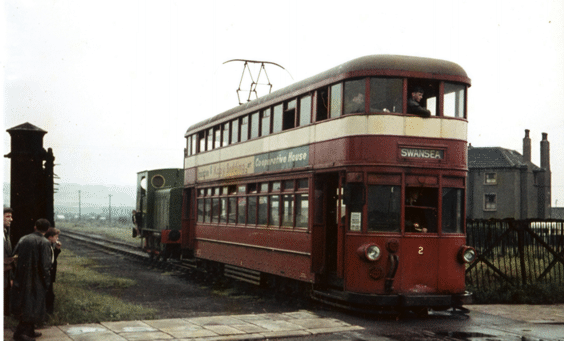
The Swansea and Mumbles Car No. 2, with HE 1697.
This was the train formation that was used for the first week of services during the university Rag Week in June 1960, but with one important difference. For those services the locomotive was at the north (ie downhill) end of the coach, so that it propelled the train up the line, as shown in the picture above. Here, though, the locomotive is at the south (ie uphill) end of the coach, so that it would have been towing the train up the line. For this reason we think that this train was probably a special one, that was run subsequently for some group of enthusiasts, but we are not sure which group.
The location where the picture was taken still exists, but it now looks very different. The roadway in the foreground of the picture is the pavement of Burton Road, and the train has just been propelled up as far as the level crossing for this road. This level crossing still exists, because what had been Burton Road is now the entrance to our Moor Road site. The track was originally our main line towards the centre of Leeds, and it still runs across this roadway (just in front of our coal pile), and (since it now can not go any further) it forms the siding that is in our car park. The big Saxby and Farmer level crossing gatepost, which is on the left of the picture, has now been re-erected at the north end of the car park, just beyond the end of this siding.
The building that can be seen behind the coach was one of a row of houses that were known as Carr Moor Side: they were all demolished in around 1970, during the preparations for the construction of the motorway (then the M1, but now the M621). If you were standing in this location now, looking in the same direction, then behind the train would be our main workshop building. Also, the track on which the train is standing no longer runs in a straight line: it bends to the right, between the workshops and the Engine House building (which is in a position where its north-west corner would be just on the left of the picture, a bit behind the gatepost). The track then curves back again round behind our platform, to rejoin its original alignment at the south end of our Moor Road yard.
The First Trams in 1960
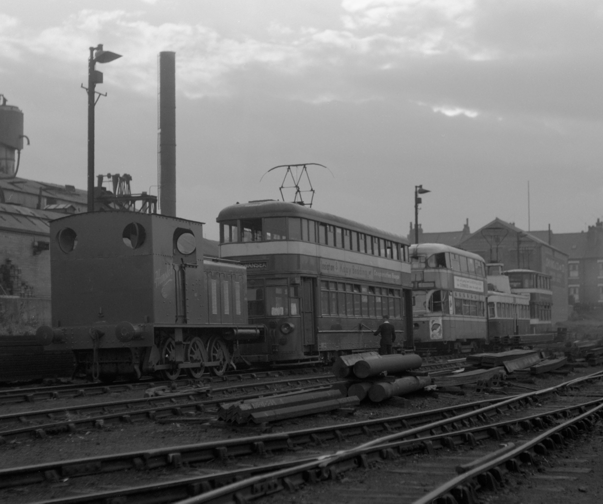
HE 1697, Swansea and Mumbles Car No. 2 and three trams in Dartmouth Yard.
This photo was taken on 16th July 1960, by Keith Terry, and is now in the archive collection of the Tramway Museum Society at Crich. We are grateful to them for permission to use it. It shows our historic diesel locomotive, Hunslet Engine Company number 1697 (built 1932), with the four passenger vehicles which by then were housed in the Dartmouth Yard of Clayton Son & Co., which was the railway's first operational headquarters.
Leeds City Tramways had only closed during the previous year, and so at this time there was almost as much focus on preserving trams as on preserving the Middleton Railway . Consequently, as well as the double deck coach Swansea & Mumbles No 2, the new society had already become home to three trams, which are shown here lined up behind it. In order, they are: Glasgow 1055 (previously Liverpool 869, and restored as this at Crich), Leeds 601 and Leeds 202. Both of the Leeds cars were subsequently damaged so badly by vandals that they had to be scrapped.
Dartmouth Yard, on Garnet Road, continued to be the headquarters of the Middleton Railway Trust until 1983, when Clayton Son & Co. closed their Dartmouth Works. The MRT then transferred its headquarters to its present Moor Road site.
Naming "John Alcock"
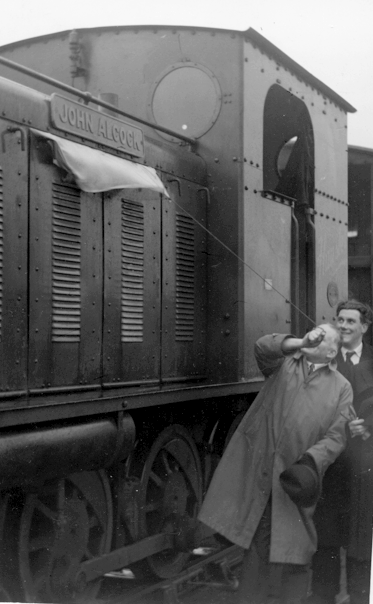
Unveiling the John Alcock nameplate on HE 1697.
The first locomotive on the preserved Middleton Railway was the historic diesel locomotive, Hunslet Engine Company number 1697, which had been built in 1932. After a varied career this had finished up as a works shunter at the Hunslet Engine Company, and through the good offices of John Alcock, who was the managing director of the company, it was first loaned to the Middleton Railway, and then sold to us at a very favourable price.
In recognition of this the Middleton Railway named the locomotive John Alcock, and this picture shows the naming ceremony. This took place on 27th January 1961, and initially we had believed that this was in the Dartmouth Yard of Clayton Son & Co., since this had been the original plan, as published in the December 1960 Old Run. According to the January 1961 issue, however, the ceremony actually took place somewhere near the Burton Road level crossing.
Similarly, we had believed initially that the name plate was being unveiled by John Alcock himself, with Fred Youell standing behind him. As will be obvious, though, not enough can be seen of the face of the person doing the unveiling to be sure of their identity. Instead, we now believe that it was not John Alcock (particularly since other photographs clearly show that he wore glasses, which this person is not doing), but rather Mr Taylor, who was the BR Motive Power Superintendent at that time, and who had been very helpful in making the arrangements for the locomotive to travel over their lines from Hunslet's works to the railway. What we do know, though, is that John Alcock was certainly present, since the Old Run records that he then drove the newly-named locomotive down to Balm Road, along with the vehicle that is seen behind it.
This vehicle behind the locomotive was initially believed to be the ex-LMS brake van M158760, which was then going to be handed over to the railway by a representative of British Railways as part of the same set of events. In fact, though, this brake van was not M158760 but an identical one, M357620, which had been on loan while some repairs were being done to M158760 prior to it being handed over to us. The handing-over ceremony then took place once the train had arrived at Balm Road.
Presentation of the LMS Brake Van

The presentation of the LMS Brake Van to the Middleton Railway.
The Middleton Railway was reopened by volunteers in 1960, and it has been operating every year since. Initially the railway was fortunate to receive a lot of support from British Railways, and this included the presentation to the Middleton Railway of various items of rolling stock. The first major example of this support was this ex-LMS goods brake van, M158760, which had just received some minor repairs at Stourton Wagon works. As part of these it had also been repainted, to indicate that it now belonged to the Middleton Railway Preservation Society, and was no longer a common user vehicle.
This picture shows the handing-over ceremony itself, which took place at the Balm Road loop, which marked the railway's junction with British Railways. The date was Friday 27th January 1961, and the ceremony followed the naming of HE 1697 as "John Alcock", which was shown in the image above. Thus, from left to right this picture shows the BR 350hp diesel shunter that had propelled the brake van round from the Hunslet Down Goods yard; the brake van itself; and the front end of the newly-named HE 1697. Unfortunately, we have no record of who any of the people involved were.
What is not visible in this picture is the other brake van, M357620, which had been on loan while the repairs were being done to M158760. This had been coupled on behind HE 1697, and it was obviously not returned to BR immediately, as the January 1961 issue of the Old Run records that on the next day the railway held an open day, when trains for visitors were run using both brake vans together.
This location on the railway still exists, and the main change to it is that there are now a lot of fences to keep people out of the national network, and in particular there is now a large set of gates across the track, roughly where the front of the 350hp shunter is. Also, in the intervening 60 years a lot of vegetation has grown up on the ground where the people are standing, so that it is no longer anything like as clear as is shown here.
The LMS Brake Van at Parkside
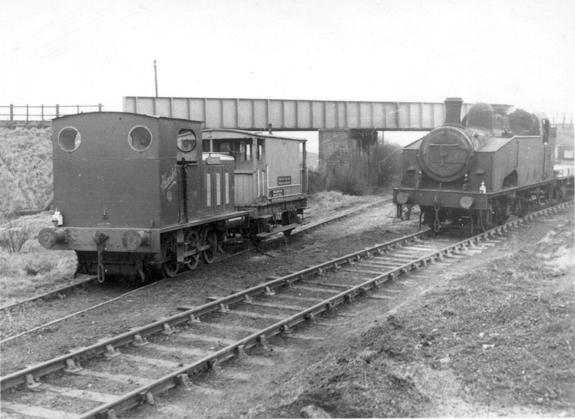
HE 1697 with the LMS Brake Van at Parkside, with a BR train.
When the Middleton Railway was first reopened by volunteers in 1960, it mainly focused initially on operating goods trains, but once the ex-LMS goods brake van (M158760) had been presented to it then the operation of passenger trains became possible. The January 1961 issue of the Old Run records that such trains were run for an open day on the day after this van had been handed over to us, using both it and the one that had been on loan to us, M357620.
This picture shows another such train, consisting of just HE 1697 and "our" brake van, which had travelled up our line towards Middleton Colliery as far as the track went. The train has halted just south of Parkside Bridge, which carried the GN branch from Beeston Junction to Neville Hill over the Middleton Railway. The track to the right is the connection from Middleton Colliery to the GN branch, and the passengers on our train were fortunate to arrive just as a class J50 tank locomotive (no 68941, based at Ardsley shed) was shunting some wagons in the exchange sidings for the line to the colliery.
The GN branch closed to traffic a few years later, and in 1971 part of its trackbed was used for the route of the Leeds South-East Urban Motorway (then the M1, now the M621) into central Leeds. This was followed in 1973 by the demolition of Parkside Bridge, so that while the Middleton Railway's track still runs where it did in this photograph, the rest of the landscape now looks nothing like this view.
Arrival of the Hand Crane
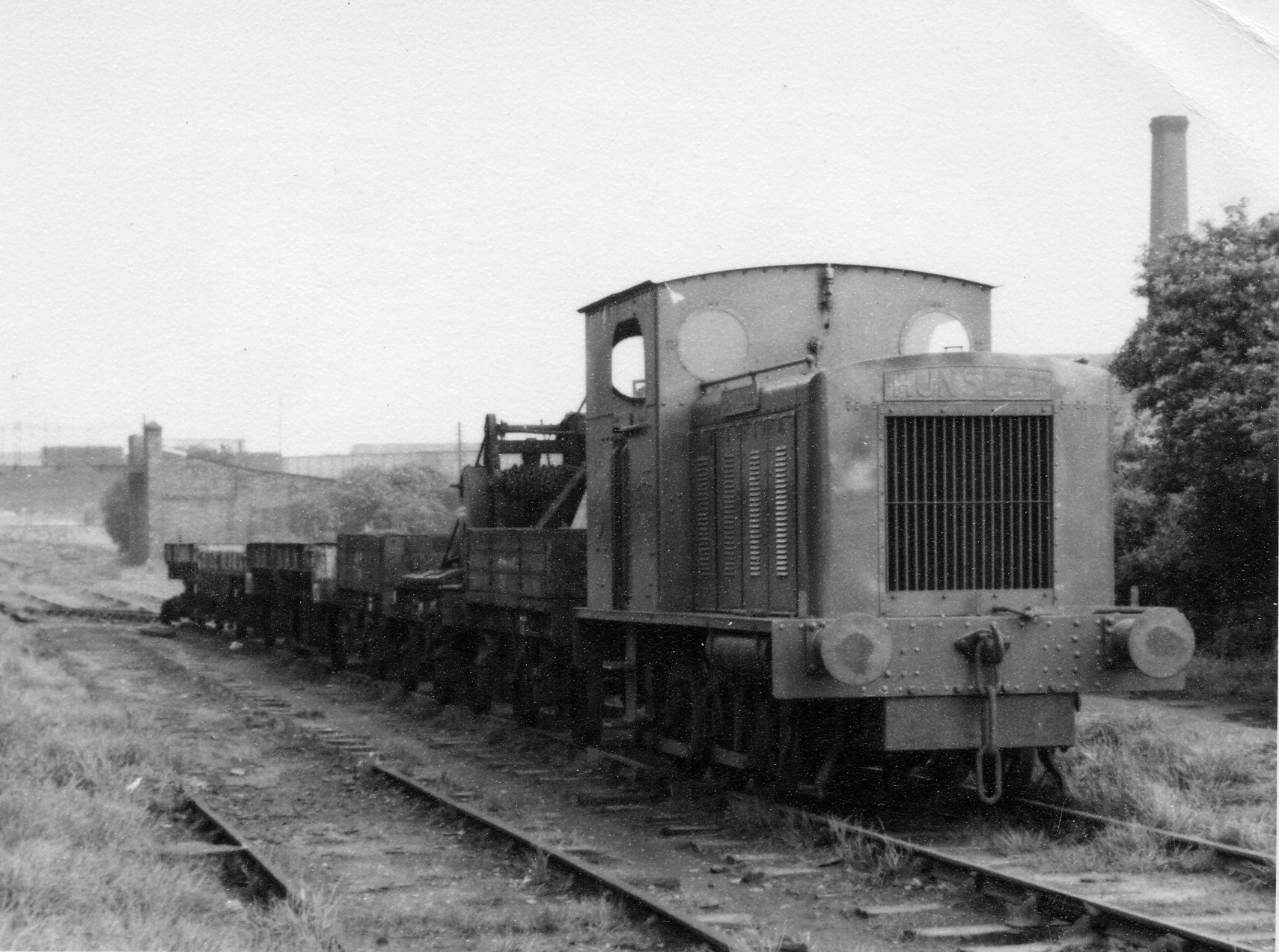
HE 1697 on the train bringing in the hand crane.
2020 saw the 60th anniversary of the reopening of the Middleton Railway by volunteers and it has been operating every year since. In the first few years it mainly operated goods trains, and this picture shows a rather special goods train, which ran on 5th May 1961. The first three wagons behind the locomotive are the set that made up the ex-Midland Railway hand crane, consisting of a match wagon (with a trestle to support the crane jib during travel), the crane itself, and then a runner wagon to provide adequate clearance behind the crane. The picture was taken by Chris Thornburn, who is probably the most long-standing member of the railway.
The locomotive is, of course, the historic diesel, Hunslet Engine Company No 1697, which had been built in 1932, and which is carrying its John Alcock name plates in honour of its designer. It is hauling the train up the Balm Road branch, towards Moor Road, and given the date we are fairly sure that the hand crane had just been delivered to the railway, and so was being worked up into Dartmouth Yard. This was an important acquisition, as at that time much of the railway's track was in fairly awful condition and so needed a lot of work doing to improve it. But track components are heavy, and having a crane - even just one that was worked by hand, as this one was - made the work a lot more manageable.
The location is between the Balm Road loop and the Beza Road level crossing, but the picture is looking towards Beza Road, and so away from the Moor End works of Clayton Son & Co. The footbridge over the railway that can be seen in the background to the picture was about where the level crossing for the service road into the City South Retail Park is now.
Observant readers will notice that in this picture the locomotive is facing in the opposite direction from the pictures above, so as to face up the hill from Balm Road rather than down towards it. Initially it had been believed that it had been turned round during July 1960, when it had to go back to Hunslet's works for a few days for maintenance work. Certainly the July 1960 Old Run records that it had travelled to Hunslet's works along the BR main line, driven by a Middleton Railway driver (but presumably with a BR driver on board as well), and evidently it had come back the same way, although this is not actually recorded.
Other images of HE 1679 in use in the few months after July 1960 clearly show, however, that it was still facing downhill at these times, and so had not been turned during this visit to Hunslet's works. Instead, it was turned at some time during March or April 1961, and presumably this involved another trip along BR, probably as far as Engine Shed Junction and round the Holbeck triangle. But the Old Run says nothing at all about this: perhaps it was all done rather unofficially, and so needed to be kept quiet!
An Early Goods Train
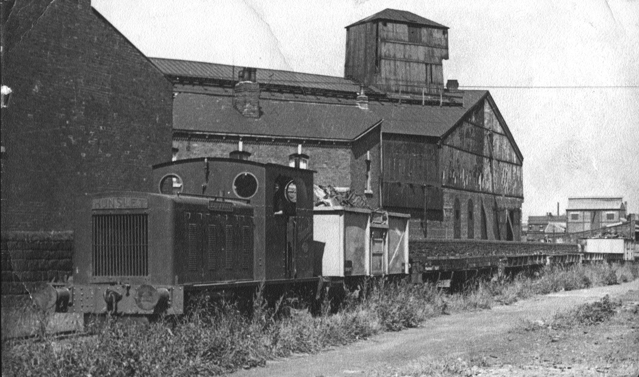
HE 1697 on a goods train.
In the first few years since the Middleton Railway was reopened by volunteers in 1960, it mainly operated goods trains, and this picture shows a typical goods train from the early 1960s. The locomotive is the historic diesel, Hunslet Engine Company No 1697, which had been built in 1932, and which is carrying its John Alcock name plates in honour of its designer. The rest of the train consists of two 16-ton wagons loaded with scrap metal, and between them 5 empty plate wagons. The train is on the railway's Balm Road branch, just above the interchange with British Railways at their Hunslet Down Goods Yard.
Initially, the fact that the 16-ton wagons were loaded with scrap metal had led us to believe that they were on their way to Sheffield from the yard of Robinson & Birdsell Ltd., so that the train was being propelled gently down the gradient towards the BR connection. This would have meant that the plate wagons would have previously arrived bringing steel stock to the Dartmouth Yard of Clayton Son & Co.
Subsequently, we discovered that the November 1962 issue of the Old Run had an image on its front cover which appeared to be very similar to this one. At that time the Old Run was produced by stencil duplication, and so the resolution of the image there is so poor that it is difficult to be sure whether it actually is the same as this one, but it seems very likely. The caption in that issue of the Old Run reads "John Alcock sets off from Balm Road sidings with a lengthy train in tow", credits the photographer as Ben Wade, and gives the date as August 1961. This date is consistent with the locomotive facing uphill, and if the rest is correct then the train must actually be heading up the gradient rather than down it. This would then mean that the scrap metal in the 16-ton wagons was being delivered to Robinson & Birdsell Ltd., instead of being sent from them to Sheffield for recycling. We clearly need to try to investigate whether "Robbies" did actually have scrap metal delivered by rail, in order to establish which of these two explanations of the train movement is most likely to be correct.
The background to the picture is provided by the Moor End works of Clayton Son & Co., while the roadway in the foregound is Beza Road. This whole area has now changed almost out of recognition: Beza Road is now a properly made road, while Moor End works has disappeared, and the City South Retail Park built on its site. In modern terms the furthest wagon of the train is almost at the Balm Road Loop level crossing, which at that time was the site of a footbridge across the railway, but this footbridge is just off the edge of the picture.
Arrival of the Sentinel
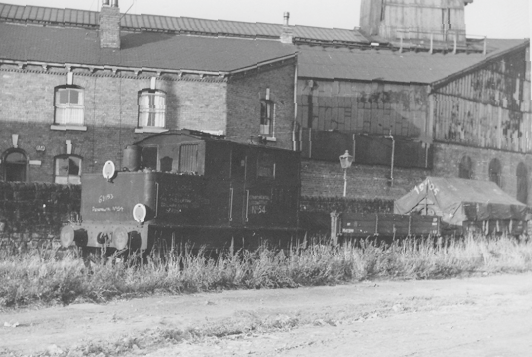
The Sentinel arriving.
In the Middleton Railway's first year following its reopening by volunteers, all of its operations were handled by the historic diesel, Hunslet Engine Company No 1697. Then, in September 1961, a second locomotive was acquired, in the form of the Sentinel vertical-boilered steam locomotive works No. 8837. This had been built in 1933 for the LNER, and had been withdrawn by British Railways earlier in the summer, from working in the Geneva Permanent-Way Yard at Darlington. By this time it was numbered Departmental Locomotive No. 54, although previously its running number had been 68153.
This picture shows the Sentinel on the day on which it arrived, 26th September 1961. It had been transported from Darlington to Holbeck MPD on a Weltrol wagon, and then it had been unloaded there and shunted down the main line to the Balm Road yard (on the up side of the line), and then the Hunslet Down Goods yard. In the picture it is waiting for HE 1697 to tow it up the Middleton Railway's line from the Balm Road loop to Clayton's Dartmouth Yard.
The location of this picture is very close to the location of the one above, so that in the foreground is Beza Road, which at this time was still an unmade road. In the background is Clayton's Moor End works, and also clearly visible are the fronts of some of the houses on the aptly-named Gasholder Street. These houses backed on to the main works building, and manfacturing gasholders was an important part of Clayton's business.
The messages that have been painted onto the back of the Sentinel's bunker (presumably before it had left Darlington) read "68153" and "Departmental No. 54", just in case there was any doubt about the identity of the locomotive. The messages that have been painted on the side of the bunker are not quite as clear, as the image is a rather low resolution one, but we think that they read "This loco is going to the Middleton Railway, Leeds (1758)", and there were similar messages on the other side of the bunker.
As with other pictures of this part of the line, this whole area has now changed almost out of recognition. Beza Road is now a properly made road, while both Moor End works and the neighbouring streets have disappeared, and the City South Retail Park built in their place.
The Presentation of Windle
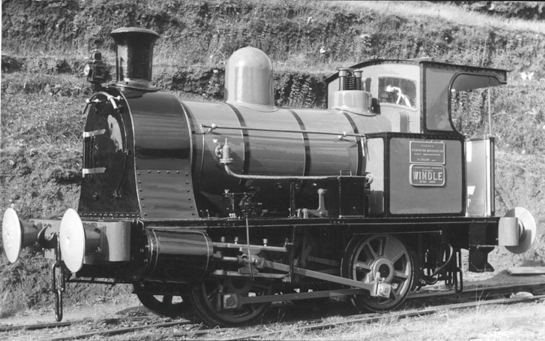
Windle at Pilkingtons.
The second steam locomotive to be acquired by the Middleton Railway came as a donation from Pilkington Brothers, of St. Helens, in the form of their well tank named Windle. This had been built by E Borrows (also of St. Helens) in 1909, as works number 53, but was now surplus to Pilkington's requirements. They did, however, want to see it preserved, and at that time there were very few options for preserving small tank engines. So they opened negotiations with the Middleton Railway, at about the same time as the railway was negotiating for the acquisition of the Sentinel, and very soon after the Sentinel arrived in 1961 agreement was reached for Windle to also come to Leeds.
Arrangements were made for Windle to be put into presentation condition, and for a presentation to take place at St. Helens, on 17th October, when this publicity photograph was taken there. The railway then had to make arrangements to accommodate the locomotive, and this took quite a bit longer, so that it was actually 9th August 1962 before it arrived in Leeds.
Initially there had been hopes that the locomotive would be able to contribute to working the goods trains, but while it looked splendid, as here, it was not actually in operating condition. Getting it to this state turned out to need quite a lot of work, and so it was not until Easter 1976 that Windle first ran trains on the railway. But these were passenger trains, as by this time the railway's goods traffic had almost ceased.
The Newly-Repainted Sentinel
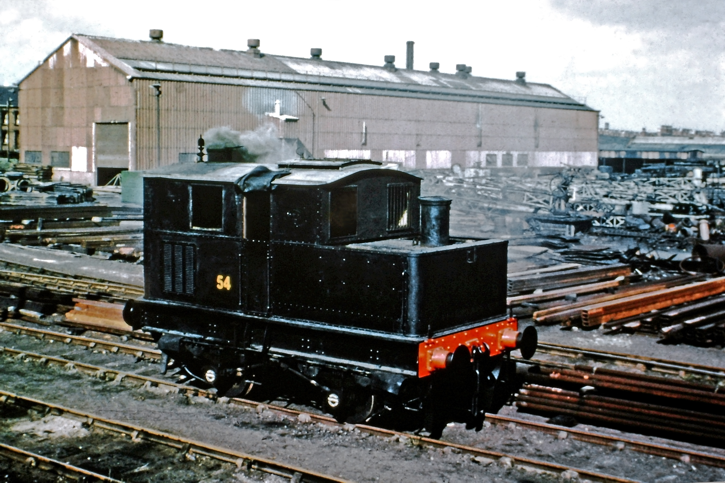
The Sentinel shortly after re-painting.
As described above, the Middleton Railway 's first steam locomotive was Sentinel No. 8837, which had been built in 1933 for the LNER, withdrawn by British Railways early in the summer of 1961, and acquired by the railway in September of that year. As the photograph of it arriving shows (although not very clearly), when it was acquired it was numbered Departmental Locomotive No. 54, and it carried the later version of the BR emblem, consisting of a lion (facing to the right) holding a wheel above a crown.
When the locomotive arrived, its paintwork was beginning to look a bit tired, and it had not been improved by the various messages that had been painted on it - probably before it left Darlington. Also, there was some controversy about whether it was appropriate for it to still carry this BR emblem, now that it was no longer in BR service. Furthermore, on BR there was some controversy about whether this version of the emblem should be used at all, given that the lion faced to the right, rather than to the left as originally designed. So, for some or all of these reasons, we believe that the decision must have been taken quite quickly to repaint the locomotive in plain black, leaving just the number 54 visible.
There is no record in the Old Run of when this repaint took place, but we suspect that it must have been in late 1961 or early 1962, since the January 1962 issue of the Old Run does record that the locomotive had "received further treatment to render it steamable", and it would be logical for the repainting to be done at the same time. What is certain is that this picture was taken soon after the locomotive had been repainted, probably some time in the Spring of 1962. Subsequently the colour print of the picture had become rather battered, and following digitisation it has needed quite a lot of blemish removal.
The location of the picture is the Dartmouth Yard of Clayton Son & Co., on Garnet Road, which was the location of the railway's headquarters until the works closed in 1983. The building in the background is their main works building, and the rest of the yard is full of steel stock and components. Judging by the angle, the photograph may well have been taken from over the wall which separated this yard from the neigbouring one of John King & Co. When the works closed the site was re-developed, and there is now almost no indication that the railway was ever here.
Track Work in Dartmouth Yard
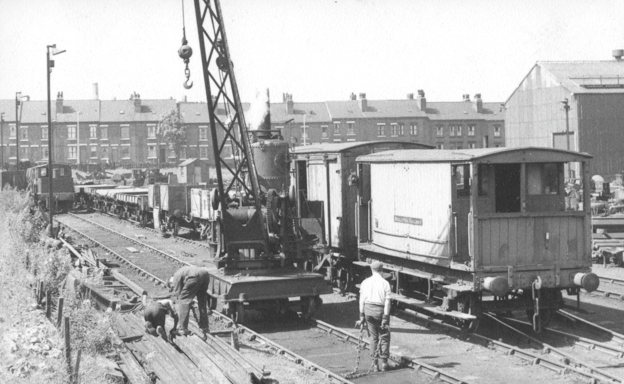
Working on the track in Dartmouth Yard, with the aid of the steam crane.
2020 saw the 60th anniversary of the reopening of the Middleton Railway by volunteers and it has been operating every year since. In the early years this operation involved a lot of collaboration with Clayton Son & Co., who allowed the railway to use its Dartmouth Yard, on Garnet Road, as the operating headquarters. This picture illustrates part of this collaboration, in which some of the MRT's volunteers were doing maintenance work on the track in the yard, assisted by the Booth steam crane, which Clayton's had effectively donated to the railway.
The track on which they were working was commonly referred to as the "back road", and was where most of the MRT's stock at that time was stabled. The ex-LMS tool van and brake van had been shunted out onto the adjacent "middle road" to be clear of the track work. We do not have a precise date for the picture, but it may well have been some time in the Spring or Summer of 1962. Similarly, we can not definitely identify any of the volunteers, since they all had their backs to the camera, but it is quite likely that the person on the right, in the white shirt with the sleeves rolled up, is Fred Youell, who as well as being the founder chairman was also the civil engineer for the first few years.
Dartmouth Works and the Yard closed in 1983, and the MRT's headquarters moved to the present Moor Road site. The Dartmouth site was re-developed, and there is now almost no indication that the railway was ever here. The steam crane is now a static exhibit at the North end of the Moor Road site. The long job of restoring the brake van has now been completed, and it is on display in the Engine House, in the livery that it carried when it first arrived.
The Sentinel in Service
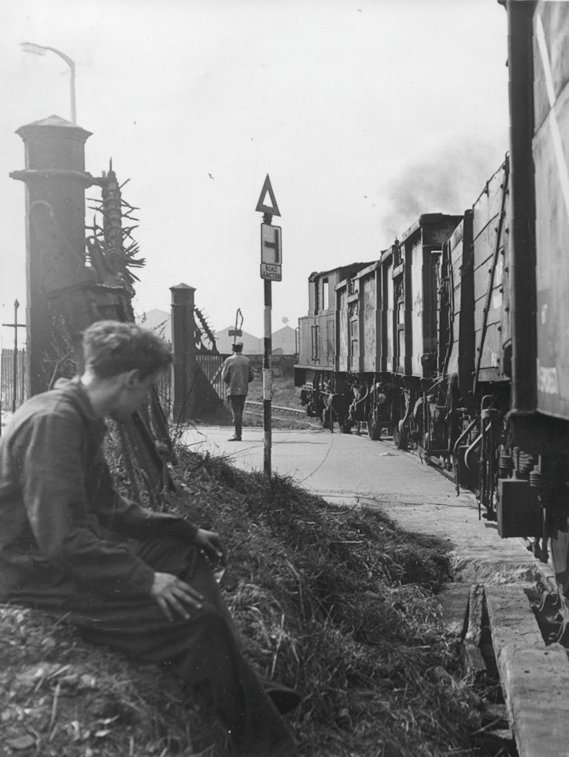
The Sentinel on a goods train crossing Moor Road.
Once the Middleton Railway had acquired its first steam locomotive, namely Sentinel vertical-boilered locomotive works No. 8837, putting it into service turned out to be quite a lengthy job. Consequently, when the Hunslet diesel John Alcock failed in July 1962, and had to go back to Hunslet's for repairs, a locomotive (D2323) had to be hired from BR to keep the trains running, until the Sentinel was able to start running trains on 4th August. John Alcock returned on 21st September, by which time the Sentinel needed further work, not least to cure a knock in one of the big ends in the engine unit, so that it was not in use again until 25th October 1964.
As a result, we have very few photographs of it operating a train on the railway during these early years, and so this may well be one of the earliest, perhaps dating from August 1962. The locomotive is hauling a goods train over the Moor Road level crossing, consisting of three 16-ton wagons and one 13-ton wagon. These will almost certainly be empty, and on their way to the yard of Robinson & Birdsell Ltd., to be loaded with scrap metal..
Since 2021 sees the Sentinel back in traffic, it would in theory be possible to take a fairly similar view of it, although we do not have any 16-ton wagons in our collection. However, the trees have grown a lot since this picture was taken, while some of the old Saxby & Farmer level crossing gates have had to be removed. Also, there would now be our Engine House building in the background. As for the boy in the foreground, who appears to be wearing a boiler suit and so may have been helping with the operation of the train, if anybody has any idea who he is then please do tell us!
More Information
Pages about categories of museum exhibits:
Other pages provide more information about:
Crane: Smith 5-ton 20054
Diesel crane
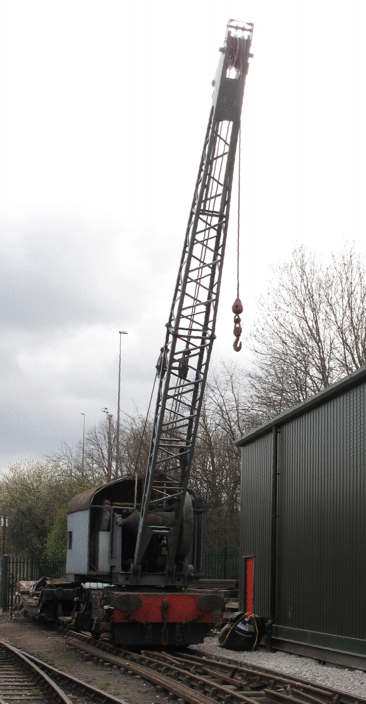
Historical note: The Smith family of Rodley started building cranes in 1840, and Thomas Smith took over the company in 1861 on the death of his father. The company was taken over by T W Ward of Sheffield in 1939, but continued to trade as a subsidiary. It was taken over again by Northern Engineering Industries in 1978, and eventually ceased manufacturing.
| Built | 1954 as a steam crane by Thomas Smith, at Leeds. Converted by them to a diesel crane in 1968. |
| Load capacity | 5 tons |
| Jib length | 35' (approximately 10.6 metres) |
| Previously worked | Supplied originally to Hull docks. Acquired from there by the Kent and East Sussex Railway in 1971. |
| Entered collection | Purchased from the Kent and East Sussex Railway in 2012 |
| Current status | Operational |
More details of this vehicle are given in our stockbook.
Go back to Smith 10-ton crane.
More Information
Other pages provide more information about:
Crane: Smith 10-ton 24579
Diesel crane
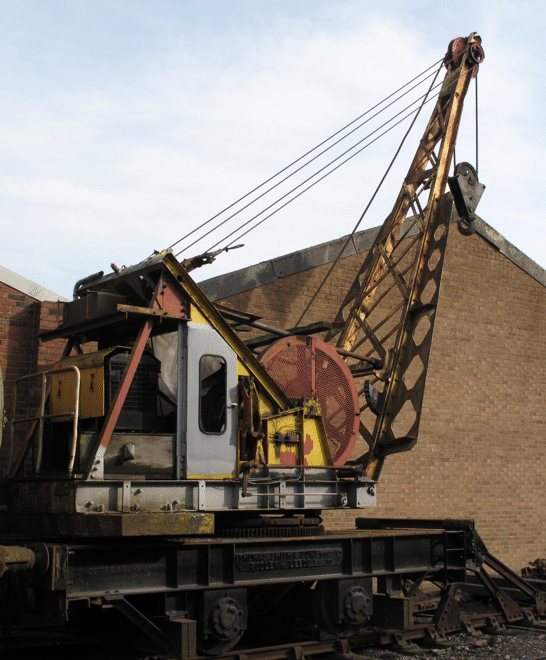
Historical note: The Smith family of Rodley started building cranes in 1840, and Thomas Smith took over the company in 1861 on the death of his father. The company was taken over by T W Ward of Sheffield in 1939, but continued to trade as a subsidiary. It was taken over again by Northern Engineering Industries in 1978, and eventually ceased manufacturing.
| Built | 1960 as a diesel crane by Thomas Smith, at Leeds |
| Load capacity | 10 tons 0 cwt |
| Jib length | 25' (approx 7.6 metres) |
| Previously worked | British Steel (latterly Corus), at Scunthorpe |
| Entered collection | Purchased from there in 2001 |
| Current status | Awaiting overhaul |
More details of this vehicle are given in our stockbook.
Go on to Smith 5-ton crane.
Go back to Isles crane.
More Information
Other pages provide more information about:
Subcategories
Projects
Projects and appeals.
Volunteering
For pages related to volunteering and membership

